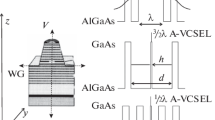Abstract
A spatially independent model of vertical-cavity surface-emitting lasers (VCSELs) is derived by integrating the spatially dependent rate equations over the cross section of the cavity of a VCSEL. The angular and radial non-uniformities of the injection current are taken into account. The well-known LP modes of a weakly-guiding cylindrical waveguide are employed to describe the transverse modal structure in the VCSEL cavity. This model is solved in a self-consistent way by using the 4th order Runge-Kutta method. The dependence of transverse mode competition on the current intensity, the angular and radial non-uniformities of the injection current, and the geometrical parameters of the electrical contact are thoroughly investigated and analyzed. The results are useful to the optimum design of the optical transverse modal structure of VCSELs.






Similar content being viewed by others
References
K. Iga, F. Koyama, and S. Kinosshita, “Surface Emitting Semi-Conductor Lasers,” IEEE J. Quantum Electron. 24, 1845–1855 (1988)
C. J. Chang-Hasnain, M. Orenstein, A. C. Von Lehmen, L. T. Florez, J. P. Harbison, and N. G. Stoffel, “Transverse Modes Characteristics Of Vertical Cavity Surface-Emitting Lasers,” Appl. Phys. Lett. 57(3), 218–220 (1990)
C. J. Chang-Hasnain, J. P. Harbison, G. Hasnain, A. C. Von Lehmen, L. T. Florez, and N. G. Stoffel, “Dynamic, polarization, and transverse mode characteristics of vertical surface emitting lasers,” IEEE J. Quantum Electron. 27, 1402–1409 (1991)
C. Degen, I. Fischer, and W. Elsaesser, “Transverse modes in oxide confined VCSELs: Influnce of pump profile, spatial hol burning, and thermal effects,” Optics Express 5(3), 38–47 (1999)
W. W. Chow, K. D. Choquette, M. H. Crawford, K. L. Lear, and G. R. Hadley, “Design, fabrication, and performance of infrared and visible vertical-cavity surface-emitting lasers,” IEEE J. Quantum Electron. 33(10), 1810–1824 (1997)
K. D. Choquette, and H. Q. Hou, “Vertical-cavity surface emitting lasers: Moving from research to manufacturing,” Proc. IEEE 85(11), 1730–1739 (1997)
G. C. Wilson, D. M. Kutchta, J. D. Walker, and J. S. Smith, “Spatial hole burning and self-focusing in Vertical-cavity surface-emitting laser diodes,” Appl. Phys., Lett. 64(5), 544–545 (1994)
J. Y. Law, and G. P. Agrawal, “Effects of spatial hole burning on gain switching in Vertical-cavity surface-emitting lasers,” IEEE J. Quantum Electron. 33, 462–468 (1997)
R. Schatz, “Dynamics of spatial hole burning effects in DFB lasers,” IEEE J. Quantum Electron. 31(11), 1981–1993 (1995)
W. Nakwaski, “Thermal Aspects of Efficient Operation of Vertical-Cavity Surface-Emitting Lasers,” Optical and Quantum Electronics 28, 335–352 (1996)
Li X. F., Pan W., Luo B., Ma D., and Deng G., “Theoretical analysis of multi-transverse-mode characteristics of vertical-cavity surface-emitting lasers,” Science and Technology 20(6), 505–513 JUN (2005)
Sabugo-Luis J, and Espana-Boquera C, “Multi-transverse mode operation in vertical-cavity surface-emitting lasers: effects of wideband modelling on spectral characteristics and noise,” Optical and Quantum Electronics 38(7), 583–603 MAY (2006)
J. J. Morikuni, P. V. Mena, A. V. Harton, K. W. Wyatt, and S.-M. Kang, “Spatially independent VCSEL Models for the simulation of diffusive turn-off transients,” Journal of Lightwave Technology 17(1), 95–102 (1999)
P. V. Mena, J. J. Morikuni, S.-M. Kang, A. V. Harton, and K. W. Wyatt, “A comprehensive cuircuit-level model of vertical-cavity surface-emitting lasers,” Journal of Lightwave Technology 17(12), 2612–2632 (1999)
C. H. Chong, and J. Sarma, “Lasing modes selection in vertical-cavity surface-emitting laser diodes,” IEEE Photonics Technology Letters 5(7), 761–763 (1993)
Y. G. Zhao, and J. G. McInerney, ‘‘Transverse-Mode Control of Vertical-Cavity Surface-Emitting Lasers,’’ IEEE J. Quantum Electron. 32(11), 1950–1957 (1996)
J. Dellunde, M. C. Torrent, J. M. Sancho, and K. A. Shore, “Statistics of transverse mode turn-on dynamics in VCSEL’s,” IEEE J. Quantum Electron. 33(7), 1197–1204 (1997)
A. Valle, “Selection and modulation of high-order transverse modes in vertical-cavity surface-emitting lasers,” IEEE J. Quantum Electron. 34(10), 1924–1932 (1998)
H. Zhang, G. Mrozynski, A. Wallrabenstein, and J. Schrage, “Numerical investigation of the effects of the injection currnt on the SHB-effects of VCSELs,” International Journal of Infrared Millimeter Wave 24(8), August (2003)
William H. Press, Brian P. Flannery, Saul A. Teukolsky, William T. Vetterling, Numerical Recipes in C, Cambridge University Press, 1988.
S. F. Yu, ‘‘Dynamic behavior of vertical-cavity surface-emitting lasers,’’ IEEE J. Quantum Electron. 32(7), 1168–1179 (1996)
M. S. Sodha, and A. K. Ghatak, Inhomogeneous Optical Waveguides, (Plenum, New York, 1977), pp. 61–71
A. W. Snyder, and J. D. Love, Optical Waveguide Theory, (Chapman & Hall, London, U. K., 1983)
Author information
Authors and Affiliations
Corresponding author
Appendix
Appendix
Rights and permissions
About this article
Cite this article
Zhang, H. Influences of the Current Transverse Profile on the Transverse Mode Competition of VCSELs Diodes. Int J Infrared Milli Waves 28, 713–723 (2007). https://doi.org/10.1007/s10762-007-9257-1
Received:
Accepted:
Published:
Issue Date:
DOI: https://doi.org/10.1007/s10762-007-9257-1




